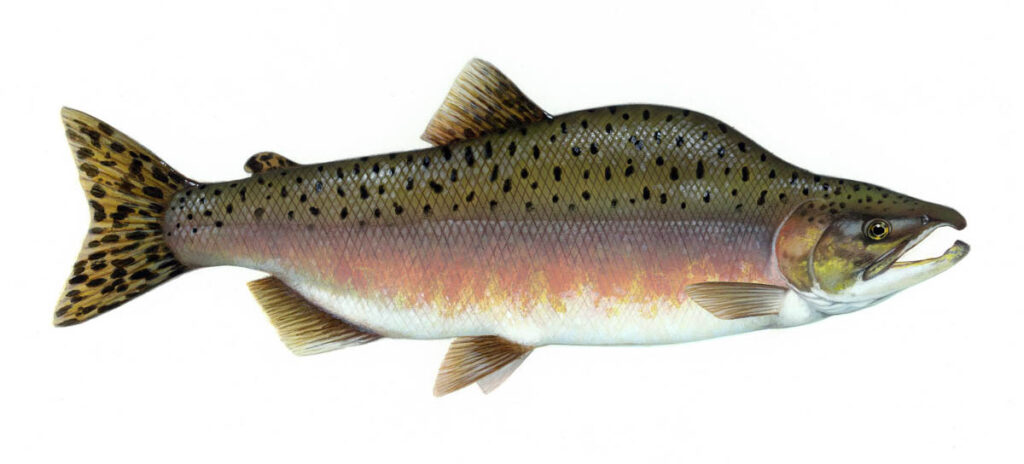Pink salmon, also known as humpback salmon (Oncorhynchus gorbuscha), is an anadromous fish in the salmon family. It is the smallest and most numerous Pacific salmon. The scientific name is derived from the Russian common name for this species, gorba (оруa), which translates as humpie.
Pink salmon are bright silver fish in the ocean. Their colouring changes to pale grey on the back with a yellowish-white belly after returning to their spawning streams (although some turn an overall dull green color). They, like all salmon, have an adipose fin in addition to the dorsal fin. A white mouth with black gums, no teeth on the tongue, large oval-shaped black spots on the back, a v-shaped tail, and an anal fin with 13-17 soft rays distinguish the fish. Males develop a prominent humped back during their spawning migration, earning them the nickname “humpies.” Pink salmon weighs an average of 4.8 pounds (2.2 kg). The largest size recorded was 30 inches (76 cm) and 15 pounds (6.8 kg).
Pink salmon prefer temperatures ranging from 5.6 to 14.6 °C, have an optimal temperature of 10.1 °C, and an upper incipient lethal temperature of 25.8 °C.
Pink salmon have a strict two-year life cycle in their native range, so odd and even-year populations do not interbreed. Pink salmon runs occur on odd years in the state of Washington. Adult pink salmon enter spawning streams from the ocean and usually return to the stream from which they came. Between late June and mid-October, spawning occurs in coastal streams and some longer rivers, as well as in the intertidal zone or at the mouth of streams if hyporheic freshwater is available. The female digs a trough-shaped nest called a redd or rede (Scandinavian word for “nest”) in the gravel of the stream bed with her tail, where she lays her eggs.
As she expels the eggs, one or more males approach and fertilize them as they fall into the redd. Following that, the female covers the newly deposited zygotes against the gravel at the top of the redd with thrusts of her tail. The female lays 1,000 to 2,000 eggs in multiple clutches within the redd, which are frequently fertilized by different males. Females guard their redds until death, which comes within days of spawning.
Pink salmon are eaten by a variety of animals throughout their life cycle, ranging from small fish, birds, and mammals in freshwater ecosystems when the salmon are eggs or fry to large fish, seabirds, and marine mammals in the ocean.

Freshwater food webs can benefit significantly from eggs and carcasses of spawned salmon adults. Pink salmon eggs are consumed by native salmonids in subarctic Norwegian rivers where pink salmon are expanding. Higher numbers of pink salmon eggs were found to reduce competition among other fish species relying on this food source in the Keogh River in Canada.
Fishery-enhancement hatcheries, particularly in the northern Gulf of Alaska, produce more than 20 million harvested pink salmon. Pink salmon are not widely cultivated in fish farms. The fish is frequently canned, smoked, or salted. Pink salmon roe is also harvested for caviar, which is a highly valued product in Asia. There is some evidence that the pink salmon fishery industry has an effect on the size of pink salmon and other salmon species, as well as the abundance of species that compete for and serve as food sources for them.
Fishing and spearfishing are not permitted in the area below the dam, as stated in the video. Fishing with a rod is usually permissible downstream, closer to the estuary. Please double-check the rules as they change from year to year.






